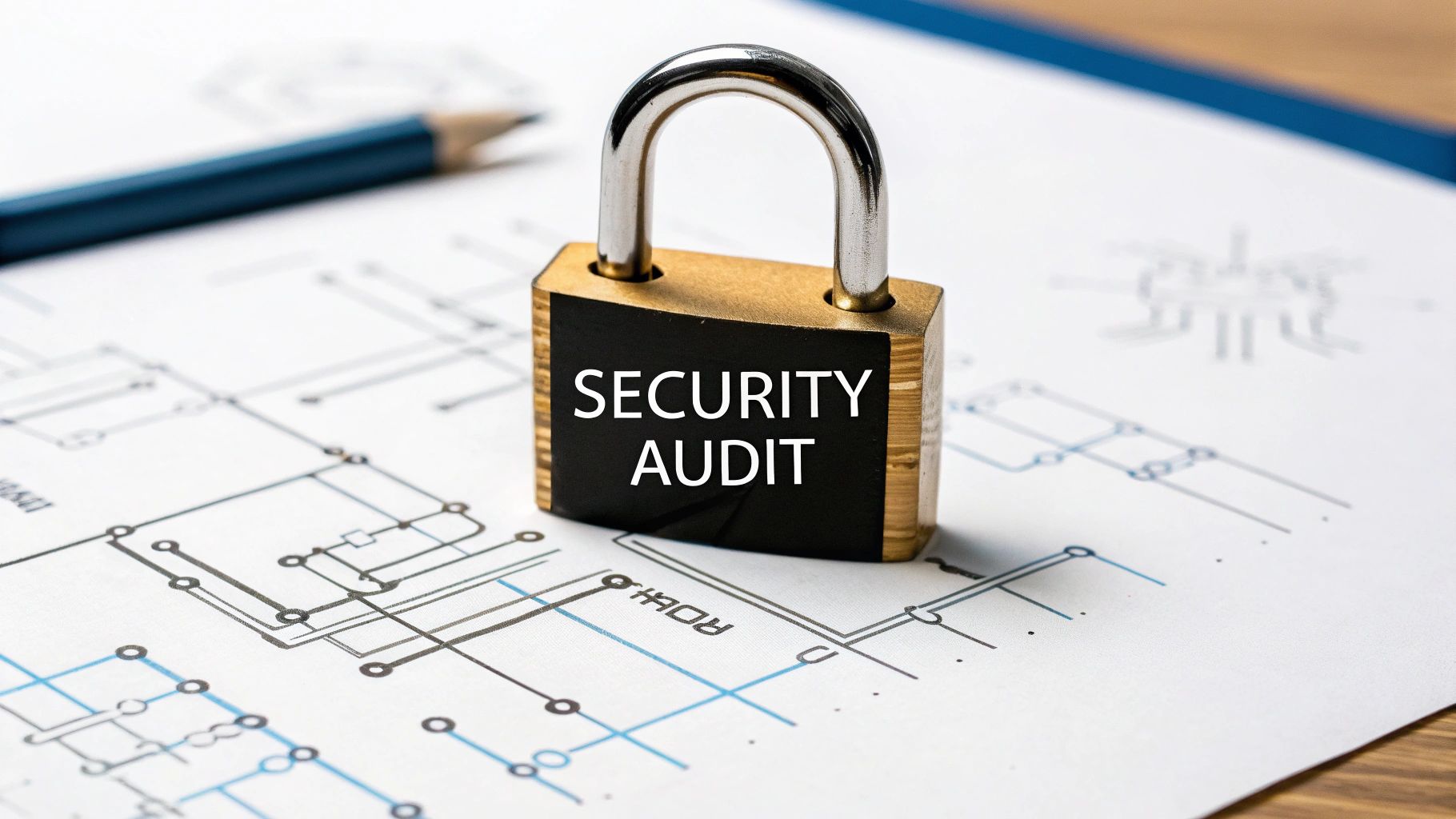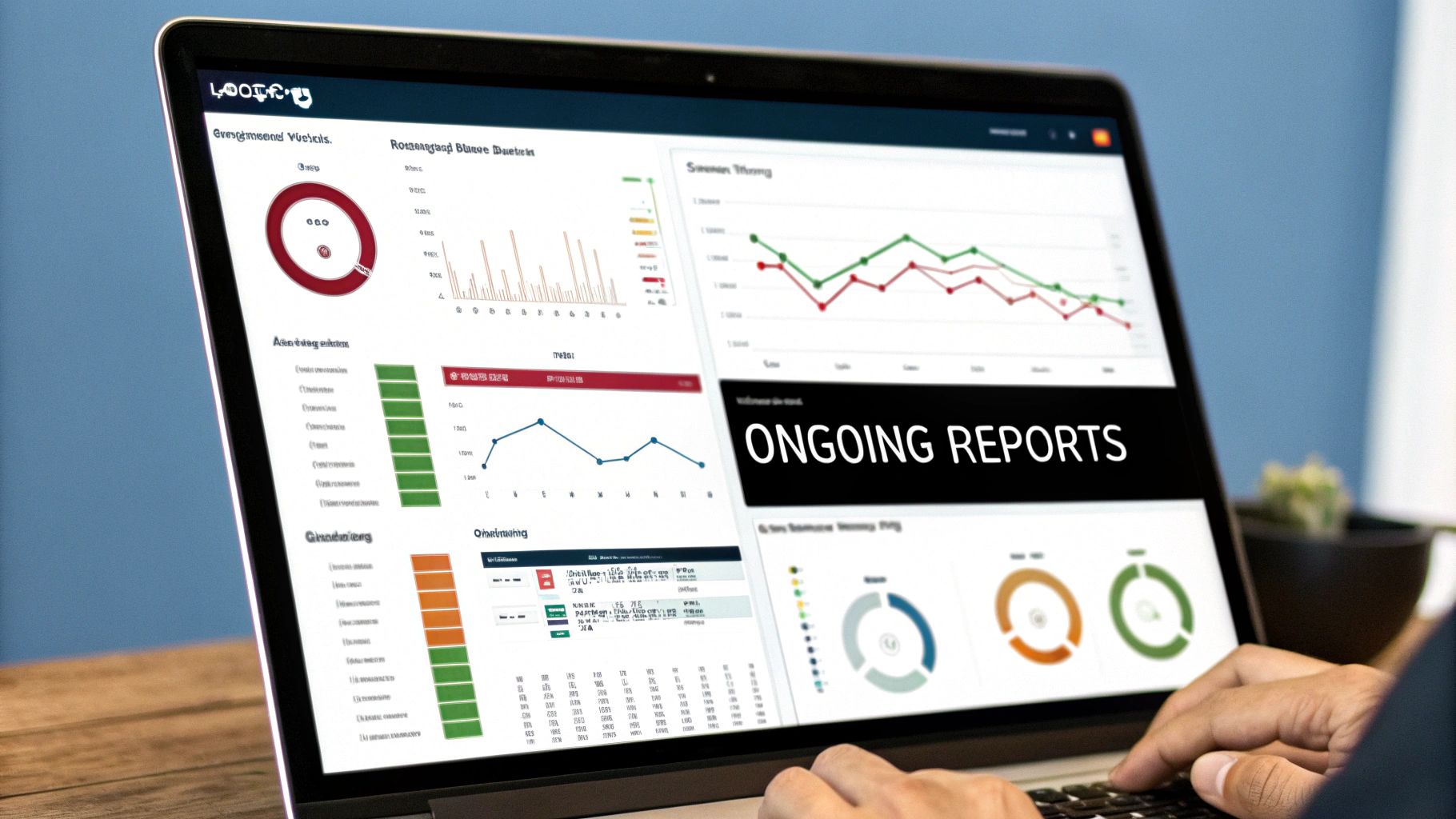 09.06.2025
09.06.2025
 09.06.2025
09.06.2025

Website security can be a real headache for UK businesses. Many owners aren't sure where to begin, often mistaking a simple scan for a true website security audit. This misunderstanding can leave them vulnerable. A proper audit is much more than a surface check. It's a thorough examination of your website's defenses, finding weaknesses before hackers do.
A website security audit is a complete evaluation of your website's security. Think of it as a comprehensive health check for your online presence. It involves pinpointing vulnerabilities, analyzing risks, and suggesting solutions to bolster your defenses. This proactive approach can shield your business from the potentially disastrous effects of a cyberattack.
For example, imagine a doctor only taking your temperature and pronouncing you healthy. A proper checkup would be far more in-depth. A thorough website security audit assesses multiple aspects of your site. This includes everything from vulnerabilities in your code to your server configurations. You can learn more about website security audits here.
Cybersecurity breaches are a persistent threat to UK businesses. A staggering 43% of businesses reported a cybersecurity breach or attack in the last 12 months, according to the Cyber Security Breaches Survey 2025. Phishing remains the most common attack, impacting 85% of businesses.
This underscores the vital need for proactive security measures like regular website security audits. Nearly half of all UK businesses have been targeted by cybercriminals. This makes robust website security absolutely critical. For a better grasp on the importance of regular security checks, consult this helpful website security checklist.
Regular website security audits are no longer optional; they are a necessity for UK businesses. They provide crucial protection against increasingly complex cyber threats. These audits help identify and address potential weaknesses before they can be exploited, saving businesses from financial loss, reputational damage, and legal consequences.
Not all security flaws are created equal. Some are minor annoyances, while others can seriously damage your UK business. This section explains the real threats facing websites like yours in plain English.
Analysis of real-world breaches reveals some vulnerabilities consistently cause the most problems. These aren't just theoretical risks; cybercriminals actively exploit them.
SQL Injection Attacks: These attacks exploit weaknesses in website code to gain access to databases. Imagine a burglar finding a hidden key to your back door. They can steal sensitive customer data, delete vital information, or even take control of your entire website.
Cross-Site Scripting (XSS): XSS vulnerabilities let attackers inject malicious scripts into your website. Think of it like poisoning food at a restaurant. Visitors unknowingly run these scripts, potentially having their login credentials stolen or being redirected to phishing websites.
Misconfigurations: Surprisingly, many breaches result from simple configuration errors. Leaving a window unlocked may seem trivial, but it's an invitation for burglars. Similarly, misconfigured server settings, weak passwords, or outdated software create easy entry points for attackers.
The Open Web Application Security Project (OWASP) Top 10 lists the most critical web application security risks. It's constantly updated based on real-world data, offering valuable insight into the most dangerous vulnerabilities. A website security audit usually checks your site against the OWASP Top 10.
Understanding your specific risk profile is crucial. An e-commerce site handling sensitive customer payment information faces different threats than a small business blog. A website security audit needs to consider these unique factors. For example, financial institutions in the UK face stricter regulations and are common targets of sophisticated social engineering attacks.
A website security audit helps you prioritize security issues based on their real business impact, not just theoretical risk. This lets you focus resources on the vulnerabilities that pose the biggest threat to your bottom line.

Forget generic checklists. This blueprint provides a proven methodology used by security professionals for conducting a website security audit. We'll guide you through each phase, from initial reconnaissance to final verification, giving you the tools to perform thorough assessments. This process helps identify vulnerabilities and protect your business.
Think of this initial phase as detective work. It involves identifying all potential entry points for attackers, known as your attack surface.
Identifying all website assets: This includes your main domain, subdomains, and any connected web applications.
Mapping your network infrastructure: Understanding your servers, databases, and other connected systems is crucial.
Analyzing publicly available information: This involves checking for data leaks, exposed credentials, and other vulnerabilities.
This phase creates a clear picture of what needs protection, forming the foundation of a comprehensive security audit.
This phase is where the actual testing begins. Automated tools are used to scan for known weaknesses.
Automated vulnerability scanners: Tools like OWASP ZAP check for common vulnerabilities, such as those listed in the OWASP Top 10.
Manual testing: While automated tools are valuable, manual testing is crucial for uncovering more complex vulnerabilities. This is like a detective meticulously examining a crime scene for subtle clues an automated system might miss.
Testing different attack vectors: This simulates various attacks, such as SQL injection and cross-site scripting, to evaluate your site's resilience.
Combining automated and manual techniques helps identify a wide range of potential security flaws.
Not every vulnerability poses the same level of danger. This phase focuses on verifying identified vulnerabilities and assessing their potential impact.
False positive elimination: Automated scanners can sometimes flag issues that aren't actual threats. Manual verification is necessary to differentiate real risks from false alarms.
Risk scoring and prioritisation: Vulnerabilities are assessed based on their potential impact and the likelihood of exploitation. This prioritizes remediation efforts, focusing on the most critical issues first.
This targeted approach allows you to concentrate on vulnerabilities that present the greatest threat to your business.
This phase puts the findings into action.
Developing a remediation plan: This outlines the steps needed to fix the identified vulnerabilities.
Implementing security fixes: This may involve patching software, updating configurations, or strengthening access controls.
Generating a comprehensive report: This documents the audit findings, risk assessments, and remediation plan.
A well-executed remediation plan addresses the identified vulnerabilities, significantly improving your website's security posture. Remember, ongoing monitoring and regular audits are essential for maintaining robust security in the long run. Integrating these practices into your operations builds a sustainable security approach.
Choosing the right security tools for your website audit can feel like navigating a maze. Marketing buzzwords often obscure the true value a tool offers. This section cuts through the noise, focusing on tools that genuinely enhance your website security audit process, rather than simply inflating the cost.
Automated vulnerability scanners are essential for any website security audit. They quickly scan your website for known vulnerabilities, saving you precious time and resources. However, not all scanners are created equal. Some excel at identifying critical issues, while others produce a deluge of false positives, leading to wasted time and effort. Choosing the right scanner involves understanding your specific needs and the tool’s capabilities.
Open-Source Options: Tools like OWASP ZAP (OWASP ZAP) are free, powerful, and highly respected by security professionals. They offer an excellent starting point for most businesses.
Commercial Solutions: Commercial scanners often provide additional features like advanced reporting and integration with other security tools. However, these come at a price. Carefully consider if the extra features justify the cost for your business.
Automated tools are valuable, but they can’t replace human expertise. Imagine a spell checker: it can catch typos, but it can't understand the nuances of language or context. Similarly, manual testing by a security professional can uncover vulnerabilities that automated scanners miss. This is particularly important for complex websites or applications.
Penetration Testing: A penetration test simulates real-world attacks to probe your defenses. This helps identify weaknesses in your system before attackers do. This proactive approach is vital for a robust website security audit.
Code Review: Manually reviewing your website's code can identify hidden vulnerabilities that automated tools might overlook. This process, while time-consuming, can uncover critical security flaws.
Selecting the right tools for your website security audit depends on several factors, including your budget, the complexity of your website, and your specific security concerns. There's no one-size-fits-all solution. When auditing your website security, consider extending the process to your email security using this helpful email security audit checklist.
Small Businesses: Free or low-cost tools and manual checks might be sufficient for smaller websites with limited resources.
Larger Organizations: Larger organizations with complex websites and sensitive data may require more advanced commercial solutions and specialized penetration testing services.
Even the best tools are useless if you misinterpret the results. Understanding the severity of identified vulnerabilities and prioritizing remediation efforts is crucial. Avoid common configuration mistakes that can render expensive tools ineffective. For example, improperly configured scanners might miss critical vulnerabilities or generate excessive false positives, wasting valuable time. Ensure you configure your tools correctly and understand the significance of the findings. This maximizes their effectiveness and ensures your website security audit delivers genuine value.

A website security audit isn't a one-size-fits-all solution. Different industries face unique cybersecurity challenges, just like different medical conditions require specialized treatments. This means adapting your security strategy to address specific risks. Understanding these industry-specific vulnerabilities is the cornerstone of an effective website security audit.
Educational institutions are treasure troves of sensitive data, from student records to groundbreaking research. This makes them prime targets for cybercriminals. Data breaches in this sector can have devastating consequences, impacting students, staff, and the institution's reputation.
For instance, a data breach at a university could expose sensitive student financial information, leading to identity theft. This underscores the vital need for robust data protection and regular website security audits within education. The risk of cyber incidents varies significantly across different UK organizations. Educational institutions are particularly vulnerable.
A recent survey revealed that 91% of universities experienced a breach or attack, compared to 43% of businesses and 30% of charities. Find more detailed statistics here.
Financial services firms handle highly sensitive financial data, making them a prime target for sophisticated cyberattacks. These institutions must adhere to strict regulations, such as the Financial Conduct Authority (FCA) guidelines, to ensure data security.
Beyond technical vulnerabilities, social engineering tactics, like phishing and pretexting, are common threats. These attacks prey on human psychology, tricking individuals into revealing confidential information or granting access to secure systems.
Therefore, website security audits for financial services must address both technical vulnerabilities and human factors. Learn more about web application security best practices here.
For retail websites, payment card skimming and other e-commerce fraud pose significant threats. Attackers inject malicious code into online checkout pages to steal customer payment information.
They might also employ techniques like credential stuffing to gain access to customer accounts. This highlights the need for secure payment gateways and strong authentication measures. Protecting sensitive financial data during online transactions requires continuous monitoring and robust, retail-focused website security audits.
A website security audit is only the first step. The real work begins after identifying vulnerabilities. Turning those findings into actionable improvements strengthens your website's security. This requires careful planning, prioritization, and collaboration. Think of it like a medical diagnosis—the diagnosis itself doesn't cure the illness, but it guides the treatment plan.
Not all vulnerabilities are created equal. A vulnerability scoring system helps prioritize which issues demand immediate attention and which can wait. This means focusing on fixing problems posing the biggest threat to your business, not just those with the highest technical severity score.
For example, a minor vulnerability on a public-facing login page might be more urgent than a high-severity vulnerability on an internal system accessed only by trusted employees. Prioritization involves understanding each vulnerability's potential impact on your business operations, customers, and reputation.
Development teams often have packed schedules. Integrating security fixes smoothly requires effective communication and collaboration. This could mean presenting audit findings clearly, concisely, and actionably, focusing on the business impact of each vulnerability instead of overwhelming them with technical jargon.
Additionally, provide developers with the resources they need for efficient implementation. This might include specific code examples, access to security training, or dedicated support from the security team. You might be interested in: How to master....
Improving security shouldn't sacrifice functionality. Security changes can sometimes introduce unexpected problems or conflicts. Thorough testing in a staging environment before implementing changes on a live website is crucial. This lets you identify and address any compatibility issues before they affect users.
Keeping your software up-to-date is crucial for preventing known vulnerabilities from being exploited. However, simply applying patches isn’t enough. A robust patch management process involves:
Regularly checking for updates
Testing patches in a staging environment before deploying them live
Documenting all patched vulnerabilities
Establishing a rollback plan for unexpected problems
This proactive approach maintains secure software without disrupting business operations.
Website security isn't a one-time fix; it’s an ongoing process. Continuous monitoring tools can help detect new vulnerabilities and suspicious activity.
Building a culture of security awareness within your organization is equally important. This goes beyond annual training. Regular communication, real-world examples of cyber threats, and clear reporting procedures empower your employees to become part of your security defense. This comprehensive strategy creates a truly bulletproof security posture for your UK business.

A single website security audit is a good first step, but it's not enough for long-term protection. Think of it like a dental check-up: essential, but you also need daily brushing and flossing for real protection. This section explores how UK businesses can build lasting security practices. These practices, like good oral hygiene, provide continuous protection and improve your overall security health.
Regular website security audits are fundamental to any effective security strategy. Just like regular health check-ups can catch problems early, frequent security assessments identify vulnerabilities before they become major incidents. Many organizations schedule these assessments quarterly or bi-annually to seamlessly integrate them into their operations. This consistency helps maintain a strong security posture, adapting to the constantly shifting threat landscape.
Choosing between internal or external audits depends on your specific needs and resources. Internal audits are a cost-effective way to handle routine checks and ensure compliance with internal policies. However, an external security audit offers an unbiased perspective and often reveals vulnerabilities overlooked by internal teams.
This independent evaluation is crucial for maintaining customer trust and meeting industry standards. Often, a combination of both approaches works best: internal teams for regular checks and external experts for deeper assessments.
Even the most robust security measures can't always prevent breaches. A well-defined incident response plan is essential; it's like having a fire drill for your website. This plan should outline clear steps to take in case of a breach.
Identifying and containing the breach
Assessing the damage and notifying affected parties
Restoring systems and implementing preventative measures
A well-rehearsed incident response plan minimizes downtime and protects your reputation if a security incident occurs.
How do you know your security efforts are working? Establishing clear metrics and frameworks helps you measure the effectiveness of your security program. This goes beyond technical jargon; it's about demonstrating the return on investment (ROI) of security to stakeholders.
Focus on measurable outcomes like reduced incident response costs, improved customer trust, and adherence to industry regulations like GDPR. This business-focused approach showcases the tangible value of security.
Cybersecurity threats are constantly evolving, requiring your budget to adapt. Regularly review and adjust your security budget based on emerging threats, new technologies, and the increasing complexity of your systems. This proactive approach ensures you have the necessary resources for robust security.
Building internal security capabilities doesn't have to be expensive. Start with basics like strong passwords, multi-factor authentication (MFA), and staff training on phishing scams. Invest in more advanced tools and training as your business and security needs grow.
Building sustainable website security practices is an ongoing process. By integrating regular website security audits, balancing internal and external expertise, and planning for evolving threats, you can establish robust and resilient security for your UK business.
Ready to build a robust and sustainable security strategy? Contact iConcept today for expert Laravel web development services in Latvia, designed to protect your business from evolving online threats. We can help you conduct comprehensive website security audits, develop effective incident response plans, and implement ongoing security practices aligned with your business goals and budget.